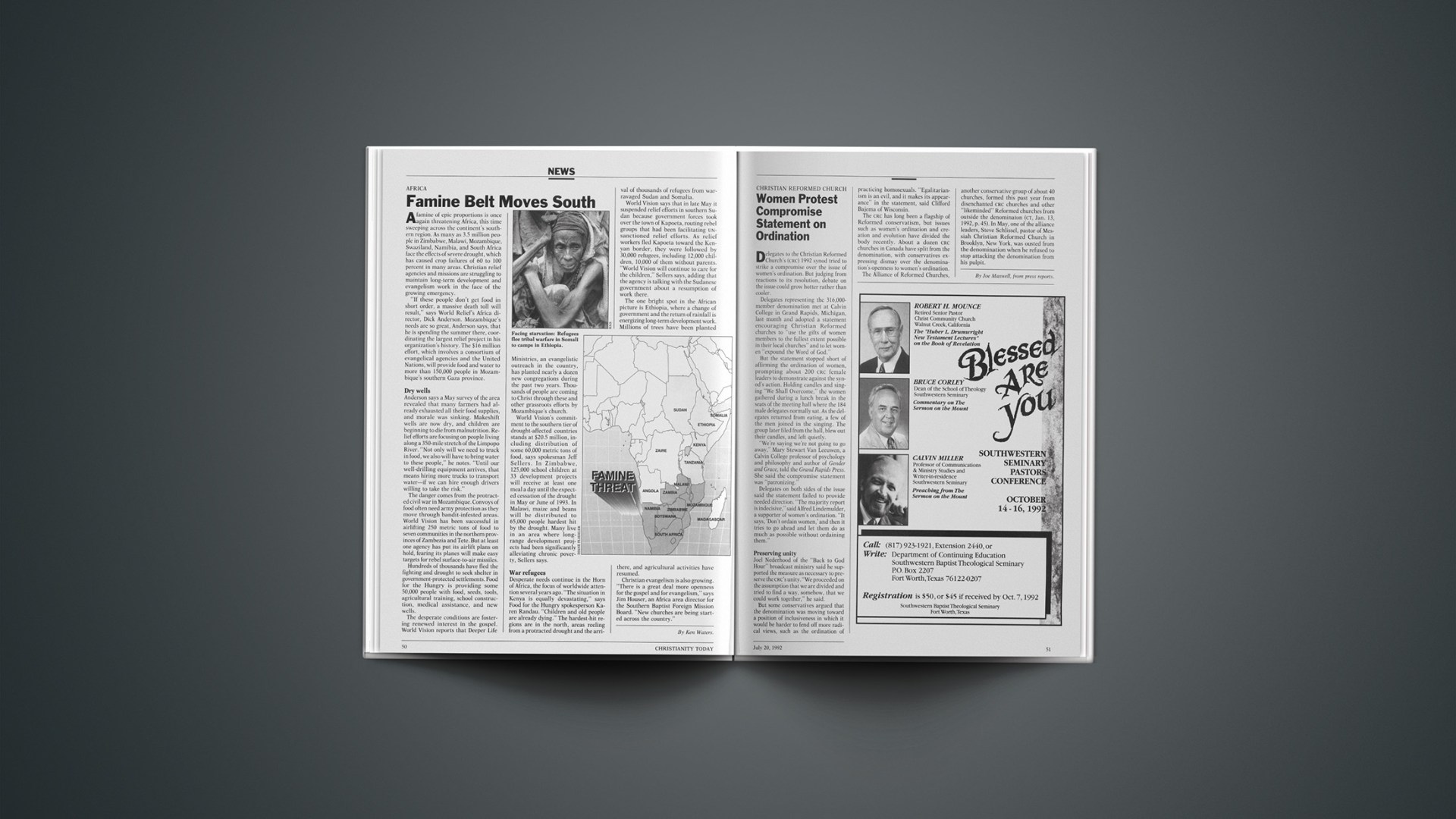Afamine of epic proportions is once again threatening Africa, this time sweeping across the continent’s southern region. As many as 3.5 million people in Zimbabwe, Malawi, Mozambique, Swaziland, Namibia, and South Africa face the effects of severe drought, which has caused crop failures of 60 to 100 percent in many areas. Christian relief agencies and missions are struggling to maintain long-term development and evangelism work in the face of the growing emergency.
“If these people don’t get food in short order, a massive death toll will result,” says World Relief’s Africa director, Dick Anderson. Mozambique’s needs are so great, Anderson says, that he is spending the summer there, coordinating the largest relief project in his organization’s history. The $16 million effort, which involves a consortium of evangelical agencies and the United Nations, will provide food and water to more than 150,000 people in Mozambique’s southern Gaza province.
Dry Wells
Anderson says a May survey of the area revealed that many farmers had already exhausted all their food supplies, and morale was sinking. Makeshift wells are now dry, and children are beginning to die from malnutrition. Relief efforts are focusing on people living along a 350-mile stretch of the Limpopo River. “Not only will we need to truck in food, we also will have to bring water to these people,” he notes. “Until our well-drilling equipment arrives, that means hiring more trucks to transport water—if we can hire enough drivers willing to take the risk.”
The danger comes from the protracted civil war in Mozambique. Convoys of food often need army protection as they move through bandit-infested areas. World Vision has been successful in airlifting 250 metric tons of food to seven communities in the northern provinces of Zambezia and Tete. But at least one agency has put its airlift plans on hold, fearing its planes will make easy targets for rebel surface-to-air missiles.
Hundreds of thousands have fled the fighting and drought to seek shelter in government-protected settlements. Food for the Hungry is providing some
50,000 people with food, seeds, tools, agricultural training, school construction, medical assistance, and new wells.
The desperate conditions are fostering renewed interest in the gospel. World Vision reports that Deeper Life
Ministries, an evangelistic outreach in the country, has planted nearly a dozen new congregations during the past two years. Thousands of people are coming to Christ through these and other grassroots efforts by Mozambique’s church.
World Vision’s commitment to the southern tier of drought-affected countries stands at $20.5 million, including distribution of some 60,000 metric tons of food, says spokesman Jeff Sellers. In Zimbabwe, 125,000 school children at 33 development projects will receive at least one meal a day until the expected cessation of the drought in May or June of 1993. In Malawi, maize and beans will be distributed to 65,000 people hardest hit by the drought. Many live in an area where long-range development projects had been significantly alleviating chronic poverty, Sellers says.
War Refugees
Desperate needs continue in the Horn of Africa, the focus of worldwide attention several years ago. “The situation in Kenya is equally devastating,” says Food for the Hungry spokesperson Karen Randau. “Children and old people are already dying.” The hardest-hit regions are in the north, areas reeling from a protracted drought and the arrival of thousands of refugees from war-ravaged Sudan and Somalia.
World Vision says that in late May it suspended relief efforts in southern Sudan because government forces took over the town of Kapoeta, routing rebel groups that had been facilitating UN-sanctioned relief efforts. As relief workers fled Kapoeta toward the Kenyan border, they were followed by 30,000 refugees, including 12,000 children, 10,000 of them without parents. “World Vision will continue to care for the children,” Sellers says, adding that the agency is talking with the Sudanese government about a resumption of work there.
The one bright spot in the African picture is Ethiopia, where a change of government and the return of rainfall is energizing long-term development work. Millions of trees have been planted there, and agricultural activities have resumed.
Christian evangelism is also growing. “There is a great deal more openness for the gospel and for evangelism,” says Jim Houser, an Africa area director for the Southern Baptist Foreign Mission Board. “New churches are being started across the country.”
By Ken Waters










